| 1. |
The TDC marks of the intake and exhaust CVVT sprockets are slightly
turned from the TDC position as shown when the timing chain is removed.
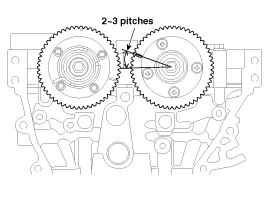
|
| 2. |
Turn the crankshaft clockwise (about 2~3 pitches) from the TDC
position (the dowel pin (A) of crankshaft is about 3° with the engine
vertical line) as rotation of the intake CVVT sprocket from the TDC
position.
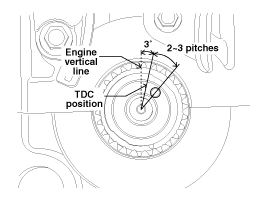
|
| 3. |
Install the timing chain guide (A).
Tightening torque:
18.6 ~ 22.6 N.m (1.9 ~ 2.3 kgf.m, 13.7 ~ 16.6 lb-ft)
|
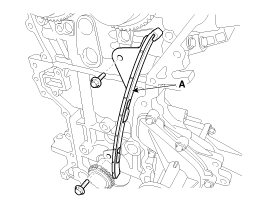
|
| 4. |
Install the timing chain tensioner arm (A).
Tightening torque:
18.6 ~ 22.6 N.m (1.9 ~ 2.3 kgf.m, 13.7 ~ 16.6 lb-ft)
|
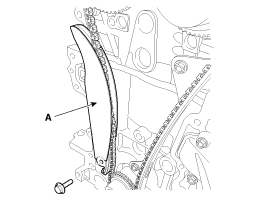
|
| 5. |
Install the timing chain.
Crankshaft sprocket (A) → Timing chain guide (B) → Intake CVVT
sprocket (C) → Exhaust CVVT sprocket (D)
| (1) |
Install the timing chain with no slack between the crankshaft
sprocket and the intake CVVT sprocket.
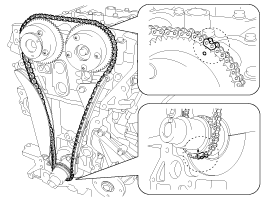
|
The timing marks of each sprocket should be matched
with timing marks (color link) of timing chain when
installing the timing chain.
|
|
| (2) |
Install the timing chain on the exhaust CVVT sprocket
with no slack while turning the CVVT assembly clockwise.
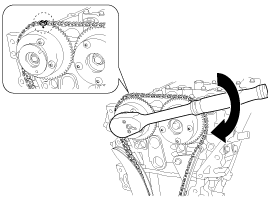
| •
|
The timing mark of the exhaust CVVT sprocket
should be matched with timing mark (color link)
of timing chain when installing the timing chain.
|
| •
|
Press down the timing chain links on the
exhaust CVVT sprocket to prevent the sprocket
from spinning.
|
|
|
|
| 6. |
Install the timing chain auto tensioner (A) and remove the stopper
pin (B).
Tightening torque:
9.8 ~ 11.8 N.m (1.0 ~ 1.2 kgf.m, 7.2 ~ 8.7 lb-ft)
|
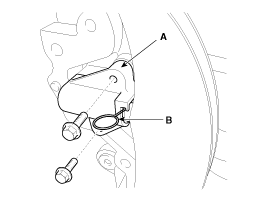
| • |
When reinstall the tensioner, check the ratchet
function of the tensioner after removing the fixing
pin by retracting the tensioner arm (A) maximally as
shown below.
|
| • |
When maximally retracted, there should be no interference
between the tensioner arm (A) and tensioner housing
(B).
|
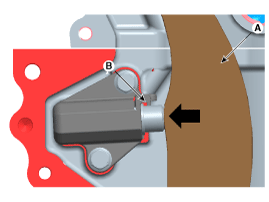
|
|
| 7. |
After rotating crankshaft 2 revolutions in regular direction (clockwise
viewed from front), confirm that the TDC marks on the intake and exhaust
CVVT sprockets are aligned with the top surface of cylinder head.
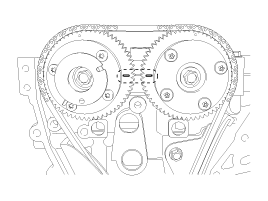
|
| 8. |
Install the timing chain cover.
| (1) |
Using a gasket scraper, remove all the old packing material
from the gasket surfaces.
|
| (2) |
The sealant locations on the chain cover and the counter
parts (cam carrier, cylinder head, cylinder block, and lower
crankcase) must be free of harmful foreign materials, oil, dust
and moisture. Spraying cleaner on the surface and wiping with
a clean duster.
|
| (3) |
Before assembling the timing chain cover, liquid sealant
should be applied on the gap between cam carrier, cylinder head
and cylinder block.
Bead width: 3.0 ~ 5.0 mm (0.11 ~
0.20 in.)
Sealant: Threebond 1217H or equivalent
|
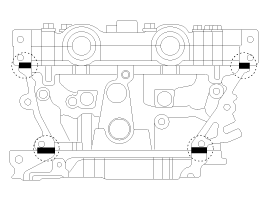
|
| (4) |
After applying liquid sealant on the timing chain cover,
assemble the cover within 5 minutes after sealant was applied.
Continuous bead of sealant should be applied to prevent any
path from oil leakage.
Bead width
Whole section: 2.5 ~ 3.5 mm (0.10 ~ 0.14 in.)
Section A: 4.5 ~ 5.5 mm (0.18 ~ 0.22 in.)
Section B: 8.0 ~ 9.0 mm (0.32 ~ 0.35 in.)
Sealant: Threebond 1217H or equivalent
|
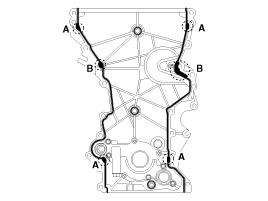
|
| (5) |
Install the timing chain cover. The dowel pins on the
cylinder block and holes on the timing chain cover should be
used as a reference in order to assemble the timing chain cover
in exact position.
Tightening torque
Bolts (A, B):
18.6 ~ 23.5 N.m (1.9 ~ 2.4 kgf.m, 13.7 ~ 17.4
lb-ft)
Bolt (C):
19.6 ~ 23.5 N.m (2.0 ~ 2.4 kgf.m, 14.5 ~ 17.4
lb-ft)
Bolts (D,E):
39.2 ~ 49.0 N.m (4.0 ~ 5.0 kgf.m, 28.9 ~ 36.2
lb-ft)
Bolt (F):
9.8 ~ 11.8 N.m (1.0 ~ 1.2 kgf.m, 7.2 ~ 8.7 lb-ft)
|
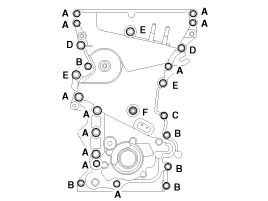
|
Do not reuse the seal bolts (C,F).
|
|
The engine running or pressure test should not
be performed within 30 minutes after the timing chain
cover was assembled.
|
|
|
| 9. |
Replace the front oil seal if necessary.
| (1) |
Apply engine oil on the edge of new oil seal.
|
Remove any debris from the lip portion of the
oil seal.
|
|
| (2) |
Install the front oil seal (A) using SST (09231-2E000,
09231-H1100).
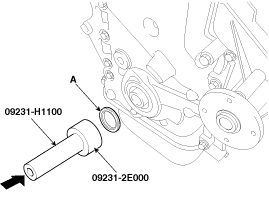
|
|
| 10. |
Install the crankshaft damper pulley (A).
Tightening torque:
196.1 ~ 205.9 N.m (20.0 ~ 21.0 kgf.m, 144.7 ~ 151.9 lb-ft)
|
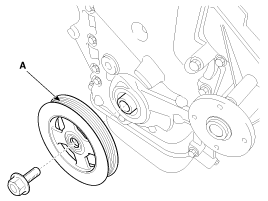
|
Do not press the pulley or apply the excessive force to
prevent the rubber part from being deformed.
|
|
There are two methods to hold the ring gear when installing
the crankshaft damper pullly.
| • |
Install the SST (09231-2B100) to hold the ring
gear after removing the starter.
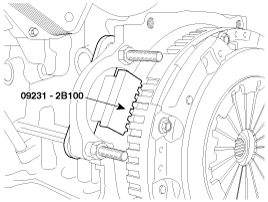
|
| • |
Install the SST (09231-3D100) to hold the ring
gear after removing the service cover.
|
| 1. |
Remove the air guard (A).
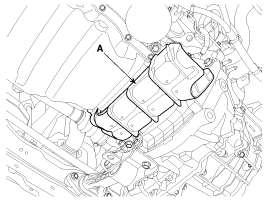
|
| 2. |
Remove the two transaxle mounting bolts (A) and
the service cover (B) on the bottom of the lower crankcase.
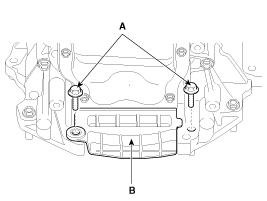
|
| 3. |
Adjust the length of the holder (A) so that the
grooves of the holder puts into the ring gears (B) at
the closest position.
|
| 4. |
Adjust the angle and length of the links (C) so
that the two transaxle mounting bolts can be fastened
into the original mounted holes.
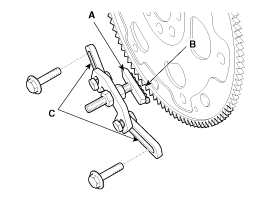
|
| 5. |
Install the SST using the two transaxle mounting
bolts. Tighten the bolts and nuts of the holder and
links securely.
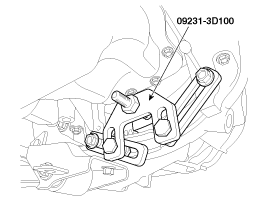
|
|
|
| 11. |
Install the water pump pulley (A).
Tightening torque:
9.8 ~ 11.8 N.m (1.0 ~ 1.2 kgf.m, 7.2 ~ 8.7 lb-ft)
|
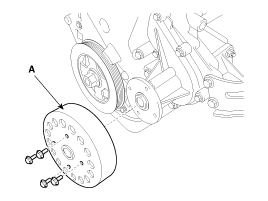
|
| 12. |
Install the front engine hanger (A).
Tightening torque:
34.3 ~ 39.2 N.m (3.5 ~ 4.0 kgf.m, 25.3 ~ 28.9 lb-ft)
|
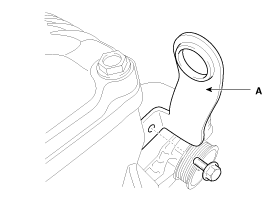
|
| 13. |
Install the drive belt.
| (1) |
Preassemble the alternator (A) temporarily.
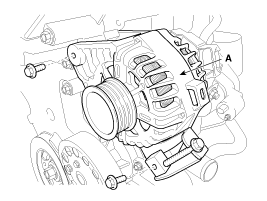
|
| (2) |
Install the drive belt (B).
|
| (3) |
Adjust the tension by turning the tension adjusting bolt
(A) clockwise. (Refer to EE group – “Alternator”)
Belt tension
New belt:
637.4 ~ 735.5 N (65 ~ 75 kgf, 143.3 ~ 165.3 lbf)
Used belt:
441.3 ~ 539.4 N (45 ~ 55 kgf, 99.2 ~ 121.3 lbf)
|
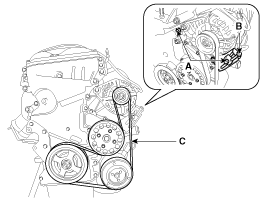
|
| (4) |
Tighten the alternator mounting bolts with the specified
torque.
Tightening torque
M10 bolt:
29.4 ~ 41.2 N.m (3.0 ~ 4.2 kgf.m, 21.7 ~ 30.4
lb-ft)
M8 bolt:
21.6 ~ 32.4 N.m (2.2 ~ 3.3 kgf.m, 15.9 ~ 23.9
lb-ft)
|
|
|
| 14. |
Install the engine mounting support bracket.
| (1) |
Install the engine mounting support bracket (B).
Tightening torque
Nut (C):
63.7 ~ 83.4 N.m (6.5 ~ 8.5 kgf.m, 47.0 ~ 61.5
lb-ft)
Bolt (D) and Nuts (E):
49.0 ~ 63.7 N.m (5.0 ~ 6.5 kgf.m, 36.2 ~ 47.0
lb-ft)
|
|
| (2) |
Connect the engine ground line (A).
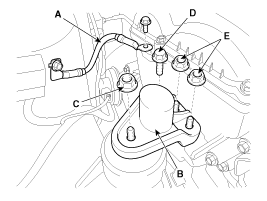
|
| (3) |
Remove the jack from the lower crankcase.
|
|
| 15. |
Install the oil pan. (Refer to Lubrication system in this group)
|
| 16. |
Install cylinder head cover.
| (1) |
The hardening sealant located on the cylinder head cover
and the gap between the timing chain cover and the cam carrier
should be removed before assembling cylinder head cover.
|
| (2) |
Apply engine oil on the lip portion of the oil seal on
the cover and outer surface of the spark plug pipes.
|
| (3) |
After applying sealant on the gap between the timing chain
cover and the cam carrier, it should be assembled within 5 minutes.
Bead width: 2.0 ~ 3.0 mm (0.08 ~
0.12 in.)
Sealant: Threebond 1217H or equivalent
|
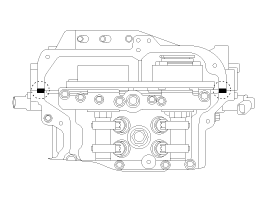
|
| (4) |
Install the cylinder head cover (A) by tightening the
bolts, in several passes, in the sequence as shown.
Tightening torque
1st step: 3.9 ~ 5.9 N.m (0.4 ~ 0.6 kgf.m, 2.9
~ 4.3 lb-ft)
2nd step: 7.8 ~ 9.8 N.m (0.8 ~ 1.0 kgf.m, 5.8
~ 7.2 lb-ft)
|
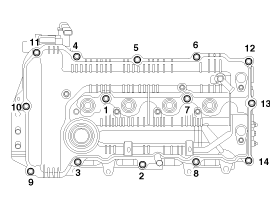
| •
|
Do not reuse cylinder head cover gasket.
|
| •
|
Before installing the cylinder head cover,
make sure the cylinder head cover gasket is
not separated from the cylinder head cover gasket
groove.
|
| •
|
The engine running or pressure test should
not be performed within 30 minutes after the
cylinder head cover was assembled.
|
|
|
|
| 17. |
Install the oil level gauge (A).
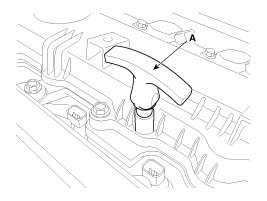
|
| 18. |
Install the ignition coils (A).
Tightening torque :
9.8 ~ 11.8 N.m (1.0 ~ 1.2 kgf.m, 7.2 ~ 8.7 lb-ft)
|
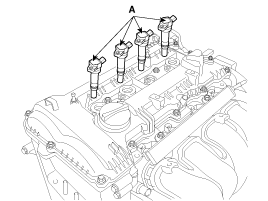
|
| 19. |
Connect the PCV (Positive crankcase ventilation) hose (A).
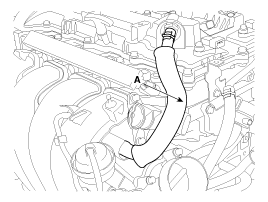
|
| 20. |
Connect the breather hose (A).
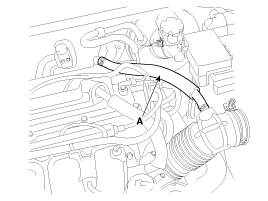
|
| 21. |
Install the wiring and protectors on the cylinder head cover and
then connect the wiring connectors and harness clamps.
| (1) |
The intake OCV (Oil control valve) connector (A)
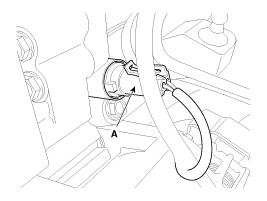
|
| (2) |
The exhaust OCV (Oil control valve) connector (A)
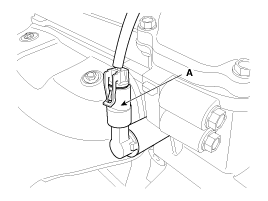
|
| (3) |
The alternator connector (A)
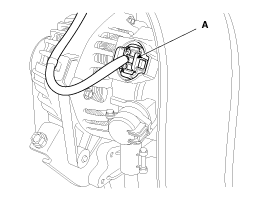
|
| (4) |
The ignition coil connectors (A)
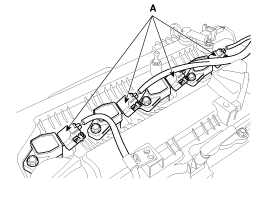
|
| (5) |
The intake CMPS (Camshaft position sensor) connector (A)
|
| (6) |
The exhaust CMPS (Camshaft position sensor) connector
(B)
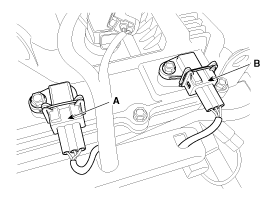
|
|
| 22. |
Install the engine cover. (Refer to Engine and transaxle assembly
in this group)
|
| 23. |
Install the RH under cover. (Refer to Engine and transaxle assembly
in this group)
|
| 24. |
Install the RH front wheel. (Refer to SS group – “Wheel”)
|
| 25. |
Connect the battery negative terminal. (Refer to Engine and transaxle
assembly in this group)
|
| 26. |
Add all the necessary fluids and check for leaks. Connect GDS.
Check for codes, note, and clear. Recheck.
| • |
Refill engine with engine oil.
|
| • |
Clean battery posts and cable terminals and assemble.
|
| • |
Inspect for fuel leakage.
|
| - |
After assembling the fuel line, turn on the ignition
switch (do not operate the starter) so that the fuel
pump runs for approximately two seconds and fuel line
pressurizes.
|
| - |
Repeat this operation two or three times, then
check for fuel leakage at any point in the fuel line.
|
|
|
Sprockets, Chain Tensioner, Chain Guide, Chain Tensioner Arm
1.
Check the CVVT sprocket and crankshaft sprocket for abnormal wear,
cracks, or damage. Replace if necessary.
...
 Hyundai Elantra MD/UD: Installation
Hyundai Elantra MD/UD: Installation




































